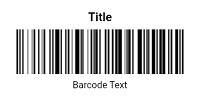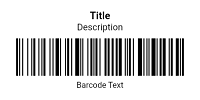The EAN-8 barcode is a compact, numeric-only symbology used primarily for encoding short numeric data. It is a subset of the EAN (European Article Number) system, designed to provide a smaller barcode option compared to the more common EAN-13. The EAN-8 barcode is particularly useful for small packages where space is limited.
Introduced as a part of the EAN standard, the EAN-8 barcode was developed to accommodate items that require a shorter barcode than EAN-13, while still providing a standardized and internationally recognized format. This compact design helps ensure that the EAN system can be applied across a wider range of product sizes and packaging types.
Technical Specifications
EAN-8 encodes an 8-digit numeric code and includes a single check digit for error detection. The barcode consists of a series of bars and spaces of varying widths, structured to include start and stop patterns, the encoded data, and the check digit.
The EAN-8 structure includes:
- Start Pattern: A specific sequence that indicates the beginning of the barcode.
- Data Characters: The 8 digits are encoded using a set pattern of bars and spaces.
- Checksum: A modulo 10 check digit is calculated to ensure data accuracy.
- Stop Pattern: Signals the end of the barcode.
Checksum Calculation
To calculate the check digit for EAN-8, follow these steps:
- Multiply each digit in the barcode by a weight factor. The weights alternate between 3 and 1, starting with the digit on the far right.
- Sum the results of these multiplications.
- Find the remainder when this sum is divided by 10.
- Subtract the remainder from 10 to get the check digit. If the remainder is 0, the check digit is 0.
This checksum method helps in verifying the accuracy of the barcode data, minimizing errors during scanning.
Advantages and Disadvantages
EAN-8's main advantage is its compact size, which is particularly useful for small items or limited packaging space. It retains the core features of the EAN system, including international compatibility and data accuracy through the inclusion of a check digit.
However, the EAN-8 barcode is limited to encoding only 7 digits of data (plus a check digit), which may not be sufficient for products that require more detailed identification. Additionally, while it offers space efficiency, the limited data capacity can be a constraint compared to the more robust EAN-13 barcode.
EAN-8 Applications
The EAN-8 barcode is commonly used in various scenarios where space constraints make a longer barcode impractical:
- Small Products: Ideal for small retail items, such as cosmetics or small food packages, where a compact barcode is necessary.
- Packaging: Used on products with limited surface area for labeling, ensuring that even small items can be tracked and managed effectively.
- Retail: Helps streamline the checkout process for smaller items, integrating seamlessly with existing retail and inventory systems.
Comparison with Other Barcode Symbologies
Compared to EAN-13, which encodes 13 digits and offers more extensive data capacity, EAN-8 provides a more compact alternative at the expense of reduced data length. Unlike UPC-A, which is similar in length but primarily used in the United States, EAN-8 is part of the broader EAN system, providing international standardization. It also contrasts with Code 128, which supports a wider range of characters but requires more space for encoding data.
The EAN-8 barcode is an effective solution for encoding short numeric data in a compact form. Its development as part of the EAN system ensures compatibility and standardization across international markets. While its limited data capacity may not suit all applications, its compact size and accuracy make it a valuable option for small products and packaging where space is at a premium.


